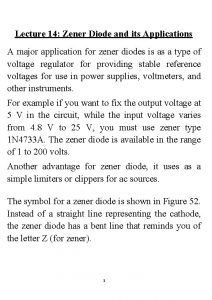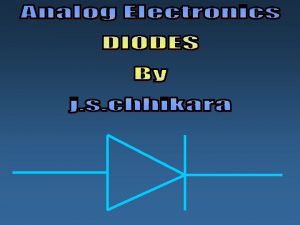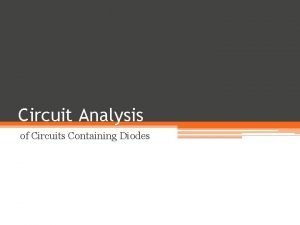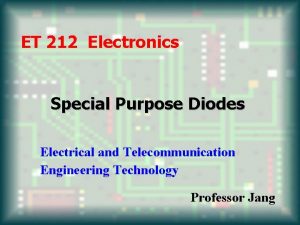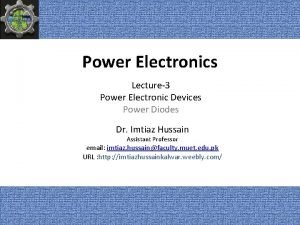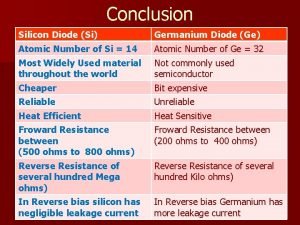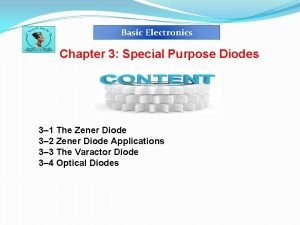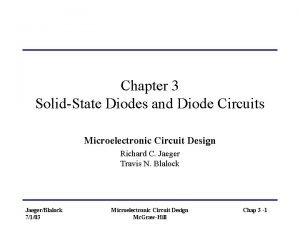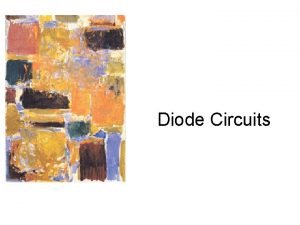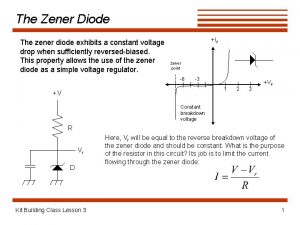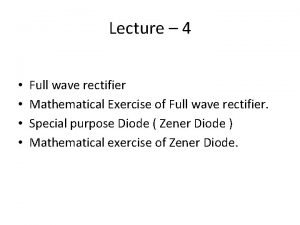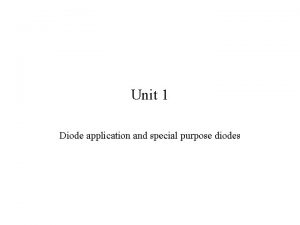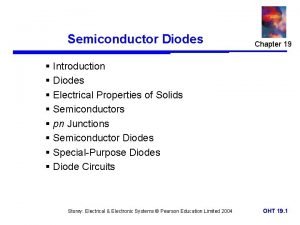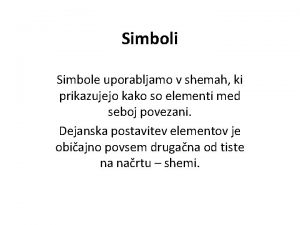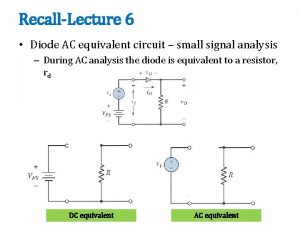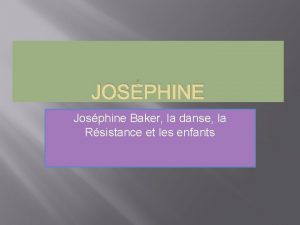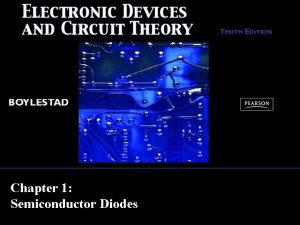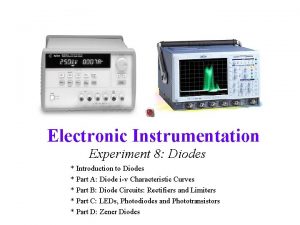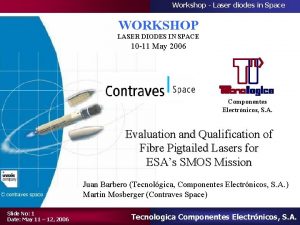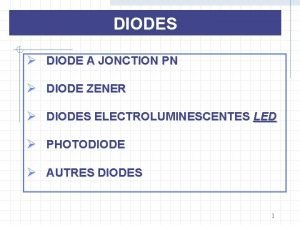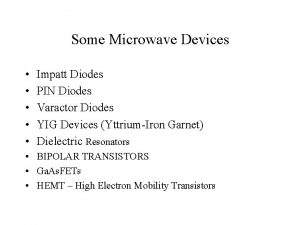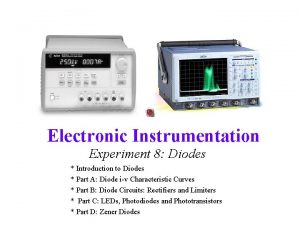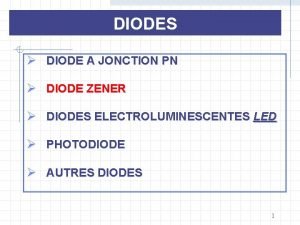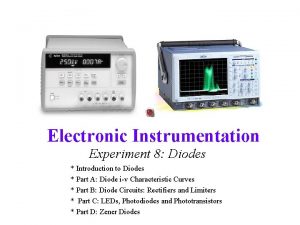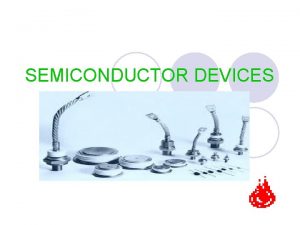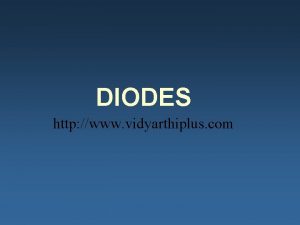DIODES C Josphine Arockiamary Assistant Professor Department of



















- Slides: 19

DIODES C. Josphine Arockiamary Assistant Professor Department of Electronics St. Joseph’s College, Trichy.

What Are Diodes Made Out Of? • Silicon (Si) and Germanium (Ge) are the two most common single elements that are used to make Diodes. A compound that is commonly used is Gallium Arsenide (Ga. As), especially in the case of LEDs because of it’s large bandgap. • Silicon and Germanium are both group 4 elements, meaning they have 4 valence electrons. Their structure allows them to grow in a shape called the diamond lattice. • Gallium is a group 3 element while Arsenide is a group 5 element. When put together as a compound, Ga. As creates a zincblend lattice structure. • In both the diamond lattice and zincblend lattice, each atom shares its valence electrons with its four closest neighbors. This sharing of electrons is what ultimately allows diodes to be build. When dopants from groups 3 or 5 (in most cases) are added to Si, Ge or Ga. As it changes the properties of the material so we are able to make the P- and N-type materials that become the diode. Si +4 Si +4 Si +4 The diagram above shows the 2 D structure of the Si crystal. The light green lines represent the electronic bonds made when the valence electrons are shared. Each Si atom shares one electron with each of its four closest neighbors so that its valence band will have a full 8 electrons.

N-Type Material: +4 +4 +5 +4 +4 When extra valence electrons are introduced into a material such as silicon an n-type material is produced. The extra valence electrons are introduced by putting impurities or dopants into the silicon. The dopants used to create an n-type material are Group V elements. The most commonly used dopants from Group V are arsenic, antimony and phosphorus. The 2 D diagram to the left shows the extra electron that will be present when a Group V dopant is introduced to a material such as silicon. This extra electron is very mobile.

P-Type Material: +4 +4 +3 +4 +4 P-type material is produced when the dopant that is introduced is from Group III elements have only 3 valence electrons and therefore there is an electron missing. This creates a hole (h+), or a positive charge that can move around in the material. Commonly used Group III dopants are aluminum, boron, and gallium. The 2 D diagram to the left shows the hole that will be present when a Group III dopant is introduced to a material such as silicon. This hole is quite mobile in the same way the extra electron is mobile in a n-type material.

The PN Junction Steady State 1 Metallurgical Junction Na - P - - Nd - - - + + + + + + + + n Space Charge Region ionized acceptors ionized donors E-Field + h+ drift _ + = h+ diffusion e- diffusion _ = e- drift

The PN Junction Steady State Metallurgical Na Junction - P - - + + Nd + + + n Space Charge Region ionized acceptors ionized donors E-Field + h+ drift + + _ + == h+ diffusion e- diffusion When no external source is connected to the pn junction, diffusion and drift balance each other out for both the holes and electrons _ == e- drift Space Charge Region: Also called the depletion region. This region includes the net positively and negatively charged regions. The space charge region does not have any free carriers. The width of the space charge region is denoted by W in pn junction formula’s. Metallurgical Junction: The interface where the p- and n-type materials meet. Na & Nd: Represent the amount of negative and positive doping in number of carriers per centimeter cubed. Usually in the range of 1015 to 1020.

The Biased PN Junction Metal Contact “Ohmic Contact” (Rs~0) _ P + Applied Electric Field n I + _ Vapplied The pn junction is considered biased when an external voltage is applied. There are two types of biasing: Forward bias and Reverse bias. These are described on then next slide.

The Biased PN Junction Forward Bias: Vapplied > 0 Reverse Bias: Vapplied < 0 In forward bias the depletion region shrinks slightly in width. With this shrinking the energy required for charge carriers to cross the depletion region decreases exponentially. Therefore, as the applied voltage increases, current starts to flow across the junction. The barrier potential of the diode is the voltage at which appreciable current starts to flow through the diode. The barrier potential varies for different materials. Under reverse bias the depletion region widens. This causes the electric field produced by the ions to cancel out the applied reverse bias voltage. A small leakage current, Is (saturation current) flows under reverse bias conditions. This saturation current is made up of electron-hole pairs being produced in the depletion region. Saturation current is sometimes referred to as scale current because of it’s relationship to junction temperature.

Properties of Diodes Figure 1. 10 – The Diode Transconductance Curve 2 ID • VD = Bias Voltage • ID = Current through Diode. ID is Negative for Reverse Bias and Positive for Forward Bias • IS = Saturation Current • VBR = Breakdown Voltage • V = Barrier Potential Voltage (m. A) IS VBR ~V VD (n. A)

Properties of Diodes The Shockley Equation • The transconductance curve on the previous slide is characterized by the following equation: ID = IS(e. VD/ VT – 1) • As described in the last slide, ID is the current through the diode, IS is the saturation current and VD is the applied biasing voltage. • VT is thermal equivalent voltage and is approximately 26 m. V at room temperature. The equation to find VT at various temperatures is: VT = k. T q k = 1. 38 x 10 -23 J/K T = temperature in Kelvin q = 1. 6 x 10 -19 C • is the emission coefficient for the diode. It is determined by the way the diode is constructed. It somewhat varies with diode current. For a silicon diode is around 2 for low currents and goes down to about 1 at higher currents

Diode Circuit Models The Ideal Diode Model The diode is designed to allow current to flow in only one direction. The perfect diode would be a perfect conductor in one direction (forward bias) and a perfect insulator in the other direction (reverse bias). In many situations, using the ideal diode approximation is acceptable. Example: Assume the diode in the circuit below is ideal. Determine the value of I D if a) VA = 5 volts (forward bias) and b) VA = -5 volts (reverse bias) a) With VA > 0 the diode is in forward bias and is acting like a perfect conductor so: RS = 50 ID VA + _ ID = VA/RS = 5 V / 50 = 100 m. A b) With VA < 0 the diode is in reverse bias and is acting like a perfect insulator, therefore no current can flow and ID = 0.

Diode Circuit Models The Ideal Diode with Barrier Potential + This model is more accurate than the simple ideal diode model because it includes the approximate barrier potential voltage. Remember the barrier potential voltage is the voltage at which appreciable current starts to flow. V Example: To be more accurate than just using the ideal diode model include the barrier potential. Assume V = 0. 3 volts (typical for a germanium diode) Determine the value of ID if VA = 5 volts (forward bias). RS = 50 ID VA With VA > 0 the diode is in forward bias and is acting like a perfect conductor so write a KVL equation to find ID: + 0 = VA – IDRS - V _ ID = VA - V = 4. 7 V = 94 m. A RS 50 V +

Diode Circuit Models The Ideal Diode with Barrier Potential and Linear Forward Resistance + V RF RF = V D I D This model is the most accurate of the three. It includes a linear forward resistance that is calculated from the slope of the linear portion of the transconductance curve. However, this is usually not necessary since the RF (forward resistance) value is pretty constant. For low-power germanium and silicon diodes the RF value is usually in the 2 to 5 ohms range, while higher power diodes have a RF value closer to 1 ohm. ID Linear Portion of transconductance curve I D VD V D

Diode Circuit Models The Ideal Diode with Barrier Potential and Linear Forward Resistance Example: Assume the diode is a low-power diode with a forward resistance value of 5 ohms. The barrier potential voltage is still: V = 0. 3 volts (typical for a germanium diode) Determine the value of ID if VA = 5 volts. RS = 50 Once again, write a KVL equation for the circuit: 0 = VA – IDRS - V - IDRF ID = VA - V = 5 – 0. 3 = 85. 5 m. A RS + RF 50 + 5 ID VA + _ V + RF

Types of Diodes and Their Uses PN Junction Diodes: Are used to allow current to flow in one direction while blocking current flow in the opposite direction. The pn junction diode is the typical diode that has been used in the previous circuits. A K P Schematic Symbol for a PN Junction Diode Zener Diodes: n Representative Structure for a PN Junction Diode Are specifically designed to operate under reverse breakdown conditions. These diodes have a very accurate and specific reverse breakdown voltage. A Schematic Symbol for a Zener Diode K

Types of Diodes and Their Uses Schottky Diodes: A K These diodes are designed to have a very fast switching time which makes them a great diode for digital circuit applications. They are very common in computers because of their ability to be switched on and off so quickly. Schematic Symbol for a Schottky Diode Shockley Diodes: A Schematic Symbol for a fourlayer Shockley Diode The Shockley diode is a four-layer diode while other diodes are normally made with only two layers. These types of diodes are generally used to control the average power delivered to a load. K

Types of Diodes and Their Uses Light-Emitting Diodes: Light-emitting diodes are designed with a very large bandgap so movement of carriers across their depletion region emits photons of light energy. Lower bandgap LEDs (Light-Emitting Diodes) emit infrared radiation, while LEDs with higher bandgap energy emit visible light. Many stop lights are now starting to use LEDs because they are extremely bright and last longer than regular bulbs for a relatively low cost. A Schematic Symbol for a Light. Emitting Diode K The arrows in the LED representation indicate emitted light.

Types of Diodes and Their Uses Photodiodes: A A K Schematic Symbols for Photodiodes K While LEDs emit light, Photodiodes are sensitive to received light. They are constructed so their pn junction can be exposed to the outside through a clear window or lens. In Photoconductive mode the saturation current increases in proportion to the intensity of the received light. This type of diode is used in CD players. In Photovoltaic mode, when the pn junction is exposed to a certain wavelength of light, the diode generates voltage and can be used as an energy source. This type of diode is used in the production of solar power.

Sources Dailey, Denton. Electronic Devices and Circuits, Discrete and Integrated. Prentice Hall, New Jersey: 2001. (pp 2 -37, 752 -753) 2 Figure 1. 10. The diode transconductance curve, pg. 7 Figure 1. 15. Determination of the average forward resistance of a diode, pg 11 Example from pages 13 -14 Liou, J. J. and Yuan, J. S. Semiconductor Device Physics and Simulation. Plenum Press, York: 1998. Neamen, Donald. Semiconductor Physics & Devices. Basic Principles. Mc. Graw-Hill, 1997. (pp 1 -15, 211 -234) 3 Figure 6. 2. The space charge region, the electric field, and the forces acting on charged carriers, pg 213. 1 New Boston: the
 Promotion from associate professor to professor
Promotion from associate professor to professor Cuhk salary scale 2020
Cuhk salary scale 2020 Zener diode and its application
Zener diode and its application What are diodes
What are diodes Circuit analysis with diodes
Circuit analysis with diodes Special purpose diodes
Special purpose diodes Power diodes types
Power diodes types Forward biased germanium diode
Forward biased germanium diode Special purpose diodes
Special purpose diodes Voltage across diode
Voltage across diode Diodes
Diodes Vt diode
Vt diode Zener diode exhibits
Zener diode exhibits Advantage of rectifier
Advantage of rectifier Special purpose diodes
Special purpose diodes Introduction to diodes
Introduction to diodes Simboli i diodes
Simboli i diodes The ac equivalent of the diode is a resistor
The ac equivalent of the diode is a resistor Physician assistant kindergeneeskunde
Physician assistant kindergeneeskunde Login assistant
Login assistant


